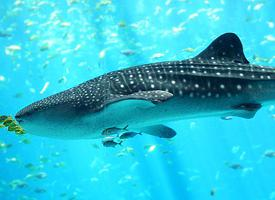
Connu aussi comme
- Žralok velrybí
- Nosozubec obrovský
Poids et mesures
| Longueur | 15 m |
|---|---|
| Poids | 34 t |
Description de l'animal
The whale shark (Rhincodon typus) is a gentle giant of the ocean, holding the title as the largest living non-mammalian vertebrate. This majestic creature can reach lengths of up to 18.8 meters (62 feet), though most whale sharks encountered are much smaller. Despite its massive size, the whale shark feeds primarily on plankton, small fish, and squid, filtering these tiny creatures through its wide, gaping mouth as it swims.The body of the whale shark is robust and streamlined, designed for long-distance travel through the open oceans. Its skin is thick and tough, adorned with a unique pattern of white spots and stripes over a dark gray background, making each individual's appearance distinctive. These patterns are not just for show; they help camouflage the whale shark in the water, breaking up its outline and protecting it from potential predators.
Whale sharks possess a wide, flat head with a blunt snout, and their mouths can be up to 1.5 meters wide. They have very small teeth, but these are not used for feeding, as their diet is consumed through filter feeding. This process involves the shark swimming with its mouth open, collecting water and food particles, then expelling the water through its gills while trapping food with gill rakers.
Found in warm waters around the globe, whale sharks prefer temperatures of about 21-25°C (70-77°F). They are highly migratory, traveling thousands of kilometers to find food and participate in breeding. The whale shark is a solitary animal, though they are sometimes seen in groups when feeding in areas with abundant food sources.
The reproduction of whale sharks remains somewhat of a mystery, with very little known about their mating habits. They are ovoviviparous, meaning the females lay eggs that hatch inside her body, with the young sharks being born fully formed and self-sufficient. Encounters with juvenile whale sharks are rare, suggesting that birthing areas are remote or well-hidden.
Despite their enormous size and potential for longevity, whale sharks face several threats from human activities. They are often victims of bycatch in fisheries, struck by ships, or targeted for their fins and meat in some cultures. As a result, the International Union for Conservation of Nature (IUCN) has listed the whale shark as Endangered. Conservation efforts are underway in many parts of the world, including protective legislation, research projects to better understand their life cycle and migrations, and eco-tourism initiatives designed to promote sustainable interactions with these gentle giants.
Whale sharks play a crucial role in their ecosystems, not only as one of the top filter feeders but also in attracting eco-tourism, which can significantly benefit local communities. Their presence in the oceans continues to fascinate and attract researchers and tourists alike, making them an iconic symbol of the marine biodiversity that still remains largely unexplored and underappreciated in our world's oceans.
Nouvelles photos d'animaux
Top 10 des animaux
- Dolphin gull (Leucophaeus scoresbii)
- Japanese macaque (Macaca fuscata)
- Stone loach (Barbatula barbatula)
- Greek tortoise (Testudo graeca)
- Russian tortoise (Testudo horsfieldii)
- Galápagos tortoise (Geochelone nigra complex)
- Diana monkey (Cercopithecus diana)
- Moustached guenon (Cercopithecus cephus)
- Common flying dragon (Draco volans)
- Galápagos penguin (Spheniscus mendiculus)